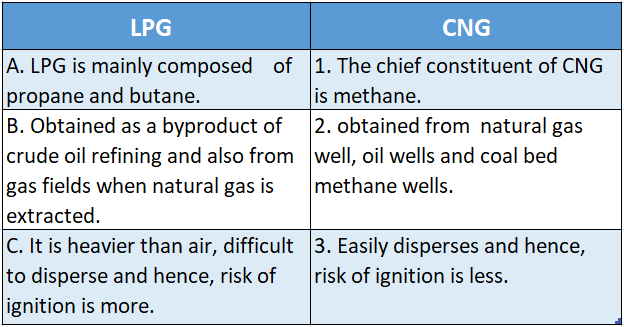Class 6 Science Question Answer WBBSE Chapter 4 Rocks And Minerals Review Questions Environment Review Questions MCQs
Question 1. The first formed rock on the earth’s surface is
- Sedimentary rock
- Igneous rock
- Metamorphic rock
- None of these
Answer: 2. Igneous rock
Question 2. When the earth was created it was made up of
- Molten rock
- Solid rock
- Gas
- None of these
Answer: 1. Molten rock
Read And Learn More: WBBSE Solutions For Class 6 School Science
Question 3. The rock that is formed by the cooling and solidification of lava or magma is called
- Metamorphic rock
- Sedimentary rock
- Igneous rock
- None of these
Answer: 3. Igneous rock
Question 4. The hot molten rock material found deep inside the earth is called
- Lava
- Magma
- Pyroclast
- None of these
Answer: 2. Magma
Question 5. When magma comes out of a crater or vent of a volcano, it is called
- Magma
- Lava
- Ash
- All of these
Answer: 2. Lava
Class 6 Science Question Answer WBBSE
Question 6. As we go deeper into the earth’s crust the temperature and pressure
- Increase
- Decrease
- Remain same
- Decrease suddenly
Answer: 1. Increase
Question 7. An example of igneous rock is
- Sandstone
- Marble
- Limestone
- Granite
Answer: 4. Granite
Question 8. The stone found near the railway tracks is
- Granite
- Basalt
- Marble
- Pumice
Answer: 2. Basalt
Question 9. When bubbling foam at the top of hot magma
- Granite
- Basalt
- Pumice
- Sandstone
Answer: 3. Pumice
Question 10. The deposition and subsequent cementation of sediments within water bodies help to form
- Igneous rock
- Sedimentary rock
- Metamorphic rock
- None of these
Answer: 2. Sedimentary rock
Question 11. An example of sedimentary rock is
- Pumice
- Sandstone
- Slate
- Basalt
Answer: 2. Sandstone
Question 12. Fossils are found in
- Sedimentary rocks
- Igneous rocks
- Metamorphic rocks
- All of these
Answer: 1. Sedimentary rocks
Question 13. Marble is a type of metamorphic rock formed from
- Granite
- Sandstone
- Limestone
- Basalt
Answer: 2. Sandstone
Class 6 Science Question Answer WBBSE
Question 14. The metal that develops a red-coloured rust, if it remains exposed to air and moisture is
- Copper
- UIron
- Aluminium
- None of these
Answer: UIron
Question 15. A metal that is found as a compound in nature is
- Mica Es
- Gold
- Copper
- None of these
Answer: 3. Copper
Question 16. When metals are found as compounds mixed with sand and soil in nature, they are called
- Rocks
- Minerals
- Non-metals
- None of these
Answer: 2. Minerals
Question 17. The type of mineral from which metals can be extracted easily and profitably is called its
- Ore
- Alloy
- Atom
- Extract
Answer: Ore
Question 18. An ore of iron is
- Bauxite
- Copper glance
- Haematite
- Augite
Answer: 3. Haematite
Question 19. Bronze is a mixture of
- Copper and zinc
- Copper and iron
- Copper and tin
- Copper and gold
Answer: 3. Copper and tin
Question 20. Chromium mixed with iron forms
- Bronze
- Stainless steel
- Brass
- Bell-metal
Answer: 2. Stainless steel
Question 21. The impressions or rocky remains of once-living organisms are called
- Fossils
- Minerals
- Metals
- None of these
Answer: 1. Fossils
Question 22. The materials that are burnt to produce heat are called
- Rocks
- Minerals
- Fuels
- None of these
Answer: 3. Fuels
Question 23. Coal, petroleum and natural gas are called
- Fossil fuels
- Black fuel
- Rock fuels
- None of these
Answer: 1. Fossil fuels
Class 6 Science Question Answer WBBSE
Question 24. When coal is heated at high temperatures in the absence of oxygen, a substance is produced called
- Rock oil
- Coke
- Coal tar
- None of these
Answer: 2. Coke
Question 25. The full form of LPG is
- Liquid Petroleum Guard
- Liquefied Petroleum Gas
- Less Polluted Gas
- None of these
Answer: 2. Liquefied Petroleum Gas
Question 26. Which one is not a fossil fuel?
- Coal
- Natural gas
- Petroleum
- Hay
Answer: 4. Hay
Question 27. Find the odd one among
- Granite
- Pumice
- Limestone
- Basalt
Answer: 3. Limestone
Question 28. Refining means
- Extracting natural gas
- Separation of various fractions of petroleum
- Burning of coal
- Sedimentation of fossil fuel
Answer: 2. Separation of various fractions of petroleum
Question 29. Fossil fuels are derived from which of the following sources?
- Organic matter trapped in sedimentary rock
- Non-organic matter trapped in
- Organic matter trapped in igneous rock
- Organic matter on the crust surface
Answer: 1. Organic matter trapped in sedimentary rock
Class 6 WBBSE Science Question Answer
Question 30. For fossils to form, the organic remains must be covered quickly by
- Scavengers
- Lava
- Water
- Sediment
Answer: 4. Sediment
Chapter 4 Rocks And Minerals Fill In The Blanks
Question 1. __________ rocks are formed by the cooling and solidification of lava on the earth’s crust or magma under the earth’s crust.
Answer: Igneous
Question 2. __________ is a type of igneous rock.
Answer: Granite
Question 3. When magma comes out of the __________ of a volcano it is called lava.
Answer: Crater
Question 4. __________ are found in sedimentary rocks.
Answer: Fossils
Question 5. The __________ rocks are found under the earth’s surface and their original character and appearance are greatly altered.
Answer: Metamorphic
Class 6 WBBSE Science Question Answer
Question 6. __________ is the metamorphosed form of granite.
Answer: Gneiss
Question 7. __________ and __________ in nature. are found as compounds
Answer: Iron, aluminium
Question 8. Metals found as compounds mixed with sand and soil are known as __________
Answer: Minerals
Question 9. The process of separating metals from the minerals is known as __________ __________.
Answer: metal extraction
Question 10. The type of mineral from which metals can be extracted easily and economically is called it’s __________.
Answer: ore
Question 11. A __________ takes place in the process of metal extraction.
Answer: Chemical change
Question 12. __________ and carbon are mixed to obtain steel.
Answer: Iron
Question 13. Brass is formed when __________ and __________ combine.
Answer: Copper, zinc
Question 14. Alloys are much more __________ than a single metal.
Answer: Stronger
Question 15. Alloy is made by __________ two or more
Answer: Melting
Question 16. __________ are the impression or rocky remains of once-living organisms.
Answer: Fossils
Class 6 WBBSE Science Question Answer
Question 17. __________, __________ and __________ are called fossil fuels.
Answer: Coal, petroleum, natural gas
Question 18. Coal is burnt to generate heat which in turn produces __________
Answer: Electricity
Question 19. LPG cylinders mainly contain liquid __________.
Answer: Propane
Question 20. Natural gas usually occurs in the __________ part of an oil trap.
Answer: Uppermost
Chapter 4 Rocks And Minerals Identify As True Or False
Question 1. The full form of CNG is Common Natural Gas.
Answer: False
Question 2. The principal constituent of Natural Gas is methane.
Answer: True
Question 3. Bitumen or Tar is produced from Iron.
Answer: False
Question 4. The naturally occurring sticky mixture of various organic compounds, water and soil is called coal.
Answer: False
Question 5. LPG is commonly known as Liquefied Petroleum Gas.
Answer: True
Question 6. Wood, paper, and hay are not fossil fuels.
Answer: True
Question 7. Fossils are seen in metamorphic rocks.
Answer: False
Question 8. Gold, solder, and electric fuse are common alloys.
Answer: True
WBBSE Class 6 Science Question Answer
Question 9. Alloys are more resistant to corrosion than single metals.
Answer: True
Question 10. Copper glance is the ore of Iron.
Answer: False
Question 11. Bauxite is the ore of aluminium.
Answer: True
Question 12. When a copper utensil is left unused for a long time it develops a red stain on it.
Answer: False
Question 13. Slate is the metamorphosed form of shale.
Answer: True
Question 14. Pumice has holes in it.
Answer: True
Question 15. Magma is the molten rock material found on the earth’s surface.
Answer: False
Chapter 4 Rocks And Minerals Match The Columns
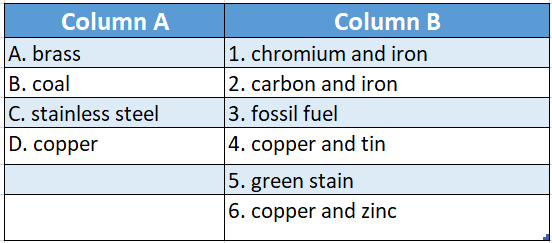
Answer: A-6,B-3,C-1,D-5
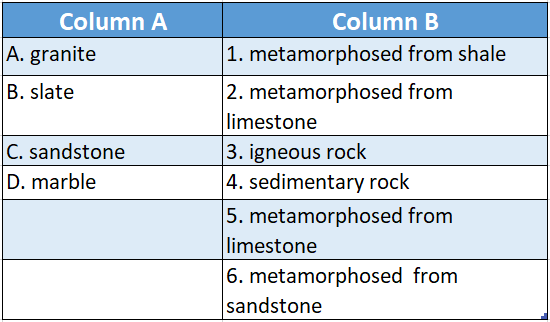
Answer: A-3,B-1,C-4,D-2
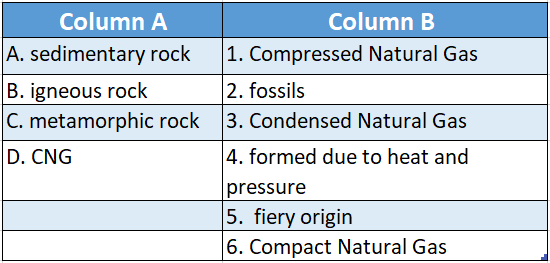
Answer: A-2,B-5,C-4,D-1
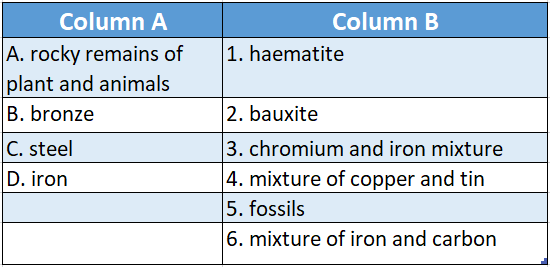
Answer: A-5,B-4,C-6,D-1
Chapter 4 Rocks And Minerals Answer In Word Or A Sentence
Question 1. What are the major types of rocks?
Answer: Igneous rock, sedimentary rock and metamorphic rock.
Question 2. What are igneous rocks?
Answer: Igneous rocks are those which have a fiery origin.
Question 3. How is igneous rock formed?
Answer: Igneous rocks were formed by the cooling and solidification of molten magma under the earth’s crust or lava on the earth’s crust.
Question 4 Name two igneous rocks.
Answer: Granite and Basalt.
Question 5. How can we identify the igneous rock pumice?
Answer: We can see holes in the igneous rock pumice.
Question 6. What are sedimentary rocks?
Answer: Sedimentary rocks are formed by the deposition and subsequent cementation of sediments within the bodies of water like seas, lakes etc.
WBBSE Class 6 Science Question Answer
Question 7. What are the sediments made up of?
Answer: The sediments are actually broken fragments derived from the erosion of primary igneous rocks.
Question 8. How are the layers of sediments compacted to form sedimentary rocks?
Answer: Due to the increase of heat and pressure of the overlying sediments, the underlying sediments get cemented and compacted to form sedimentary rocks.
Question 9. Name two sedimentary rocks.
Answer: Sandstone and Shale.
Question 10. What do we find in the sedimentary rocks?
Answer: Fossils or the rocky remains of dead plants and animals.
Question 11. What causes igneous or sedimentary rocks to change into metamorphic rocks?
Answer: Due to excessive heat and pressure igneous and sedimentary rocks undergo physical and chemical changes to form metamorphic rocks.
Question 12. What are minerals?
Answer: Minerals are naturally occurring solid inorganic, crystalline substances with a definite chemical composition.
Question 13. What is metal extraction?
Answer: The process of separating metals from the mineral (ore) is known as metal extraction.
Question 14. What is an ore?
Answer: The type of mineral from which a metal can be extracted easily and profitably (economically) is known as its ore.
Question 15. What are alloys?
Answer: The homogeneous mixture or combination of different metals or metals with non-metals in a fixed ratio (especially to give strength) is called an alloy. For example, stainless steel is an alloy of chromium and iron.
Question 16. Mention two important characteristics of an alloy.
Answer: Alloys are much stronger than single metals and do not easily respond to chemical reactions.
Question 17. How is an alloy made?
Answer: An alloy is made by melting of two or more elements together, one of which is a metal. The mixture is then cooled to obtain a solid substance called an alloy.
WBBSE Class 6 Science Question Answer
Question 18. What is a fossil?
Answer: The impressions or the rocky remains of once-living organisms are called fossils.
Question 19. Write two uses of fossils.
Answer: Fossils are useful tools for dating rocks and also for showing the long history of life on Earth.
Question 20. Why are coal, petroleum or natural gas called fuels?
Answer: Coal, petroleum and natural gas are called fuels as when they are burnt they produce heat and power.
Question 21. Write one use of coal.
Answer: Coal is burnt to generate heat which in turn produces electricity.
Question 22. Write one use of petroleum.
Answer: Petroleum is widely used as a fuel for automobiles like cars, lorries, motorcycles etc.
Question 23. What is the full form of CNG?
Answer: Compressed Natural Gas.
Question 24. Name the full form of LPG.
Answer: Liquefied Petroleum Gas.
Question 25. What is amalgam?
Answer: An alloy of mercury metal with one or more other metals is known as amalgam. For example, Sodium amalgam is composed of sodium and mercury.
Chapter 4 Rocks And Minerals Qshort Answer Type Questions
Question 1. What is magma?
Answer: Deep inside the earth due to increasing temperature and pressure the rocks remain in a molten state as magma.
Question 2. What is lava?
Answer: When the magma comes out of the cracks of the crust or through the crater (vent) of a volcano it is called lava.
Question 3. How are igneous rocks formed under the earth’s crust?
Answer: Deep inside the earth due to increasing temperature and pressure the rocks remain in a molten state as magma. This magma rises to the surface through cracks of the crust.
While coming out it undergoes changes in temperature and pressure that causes it to cool, solidify and crystalize beneath the surface of the Earth’s crust to form intrusive igneous rocks, e.g. Granite.
Question 4. How are igneous rocks formed above the earth’s crust?
Answer: The magma when it comes out of the cracks of the crust or through the crater (vent) of a volcano is called lava.
This lava cools and solidifies on the earth’s surface quickly to form another kind of igneous rock, known as extrusive igneous rocks, e.g. Basalt.
Question 5. Why are holes seen on the igneous rock pumice?
Answer: Pumice is formed when there is rapid cooling and depressurization.
Holes are usually seen on the pumice stone. These holes are formed when the dissolved gases of the hot magma escape into the air and the froth at the top of the hot magma quickly cools and solidifies.
Question 6. How do the softer sediments under the sea turn into sedimentary rocks?
Answer: Sediments derived from igneous rocks are eroded and transported by the agents of denudation (rain, wind, river, glacier, etc.) and are deposited in layers in the sea. When sedimentation continues the older rock layers become buried deeper.
Over a long period, due to the increase in heat and pressure of the overlying sediments the underlying sediments get compacted and cemented and turn into sedimentary rocks.
Question 7. How do minerals differ from ores? or Why “all ores are minerals but all minerals are not ores”?
Answer: If a metal has more than one mineral form, then it is not necessary that all of them are ores.
For every mineral deposit, there is a set of conditions, such as the level of concentration of the metal and the size of the deposit that the deposit may be worked at a profit.
If a mineral deposit is sufficiently rich to be worked at a profit, it will then be called an ore deposit otherwise not. So, all ore deposits are mineral deposits, but the reverse is not true.
Question 8. Why do metals after extraction look different from their ores?
Answer: Metals, after they are extracted from ores, look different from their ores. This is because a chemical change takes place in the process of metal extraction.
Question 9. Why are most of the metals used today in the form of alloys?
Answer: Today, more than 90% of metals used are in the form of alloys. This is because alloys have many advantages that a single metal does not have.
Alloys are much stronger than a single metal, has the ability to withstand heavy weight, do not readily respond to chemical reactions and are resistant to corrosion.
Question 10. How did the dead bodies of animals come inside the rock and become fossils?
Answer: Millions of years ago the fish, the snail and the sea star were all alive. After the death of these animals, their bodies got buried under water or under the surface of the earth.
The soft fleshy parts of their bodies decayed in the course of time. Soon after the initial decay process, the remains of their bodies got covered with sediments.
The remains after undergoing a variety of physical and chemical changes, got transformed into rocks then. The impressions or rocky remains of once-living organisms are called fossils.
Question 11. What are fossil fuels?
Answer: The materials such as coal, gas or oil that are burnt to produce heat and power are called fuels. Coal, gas and oil are obtained from the remnants or dead remains of plants and animals that lived a long time ago.
These dead remains had undergone changes for millions of years and were transformed into fossils. Hence, coal, petroleum (oil) and natural gas are known as fossil fuels.
Question 12. Why are coal, petroleum and natural gas called fossil fuels?
Answer: Coal, petroleum and natural gas are fuels formed from the dead remains of ancient plants and animals which had undergone changes for millions of years and were transformed into fossils.
Hence, they are called fossil fuels.
Question 13. How is metallurgical Coke produced?
Answer: Coke is produced when coal is heated at a high temperature (about 1100°C) in the absence of oxygen.
Question 14. What is CNG and why is it used widely in our country?
Answer: Compressed Natural Gas or CNG is made when purified natural gas is compressed (put under pressure) and stored in a cylinder and used as fuel.
In our country as well as in many other countries CNG is used to run public transport, especially buses, because it causes less pollution than other commonly used fuels like diesel or petrol.
It is also used as fuel for cooking and power generation.
Question 15. Mention three differences between LPG and
Answer:
